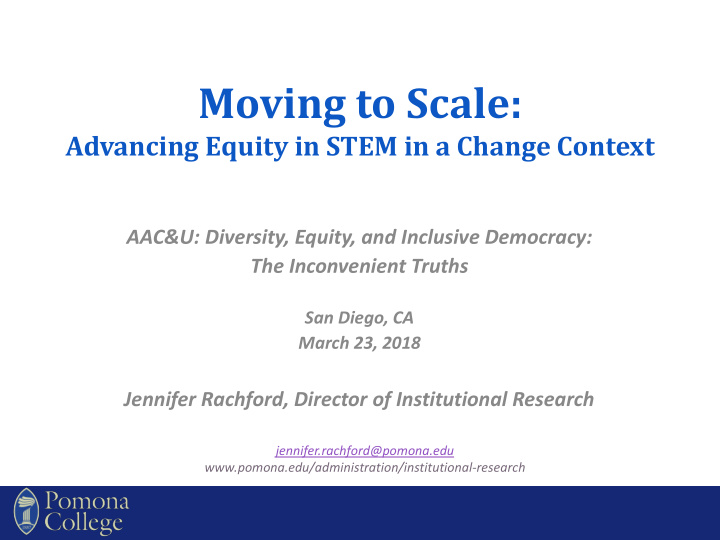



Moving to Scale: Advancing Equity in STEM in a Change Context AAC&U: Diversity, Equity, and Inclusive Democracy: The Inconvenient Truths San Diego, CA March 23, 2018 Jennifer Rachford, Director of Institutional Research jennifer.rachford@pomona.edu www.pomona.edu/administration/institutional-research
• Small, residential, private liberal arts college located 35 miles east of Los Angeles. • 1671 degree-seeking undergraduates. • 48 percent students of color; 27 percent URM; 11 percent international; 17 percent first- generation. • 186 full-time faculty. Student-faculty ratio = 8:1. • Comprehensive liberal arts curriculum offering 48 majors in arts/humanities, natural sciences, social sciences, and interdisciplinary fields. • Six-year graduation rate = 93 percent overall, with rates for Black and Latinx typically over 90 percent.
Change looks like this at Pomona… URM (%) Total of color (%) 60.0% 50.0% 40.0% 30.0% 20.0% 10.0% 0.0% 08 09 10 11 12 13 14 15 16 17 First Time Full Time Entering Cohort President G. Gabrielle Starr
And this……
And this…… https://www.pomona.edu/administration/academic-dean/faculty-jobs/how-prepare-diversity-statement
And also this.
Moving to Scale Scaling Can we replicate Awareness success under a variety of Patterns of inequity conditions?* become clear. Experimentation Beliefs begin shifting and innovations emerge. *What works, for whom, under what conditions? * Bryk, A.S., Gomez, L.M., Grunow, A., & LeMahieu , P.G. (2015). Learning to improve: How America’s schools can get better at getting better. Cambridge, MA: Harvard Education Press.
Persistent patterns of attrition in STEM
Positive Deviance: Intro Biology Introduction to Genetics, taught by Professor Lenny Seligman
Experimentation with Intro Course Design Introduction to Genetics is the first Biology course students encounter at Pomona and Percent earning a grade of “C” or serves as a gateway to the life sciences. To lower in Intro Bio address persistent gaps in performance, one section of the course was redesigned to include: • Small size (from 17- 24 students), with cohort students pre-enrolled. • Mandatory attendance at weekly, mentor-led problem sessions. • Interactive lecture and group learning. • Direct, careful engagement of stereotype risks to avoid stigmatization (“first day script”).
Strengthening Co-Curricular Support Academic Cohort Programs Peer Academic Coaches • Faculty-led • Weekly group meetings Quantitative Skills Center (QSC) • Individual advising • Focus on how to “do college” • Examples: • POSSE Chicago • POSSE STEM Miami • High Achievement Program (HAP) • Pomona Science Scholars (PSS) • Pomona Scholars of Math (PSM) QSC staff members: Nita Kansara, Dylan Worcester, and Travis Brown
The Big “A - HA:” We CAN overcome equity gaps in STEM. Percent of students earning a grade of “C” or lower in Intro Biology: “Traditional” sections vs. redesigned “small sections.”
The Big “A - HA:” Seeing (the data) is believing. Common exam questions across traditional and redesigned sections made it possible to verify that the reduction in performance gaps was “real” (i.e., not an artifact of grade inflation).
Strengthening Quantitative Pathways to STEM Success at Pomona • Cultivating faculty awareness and agency around equity issues in STEM. • Integrating high-impact, cohort-based practices into teaching and advising. • Strengthening the foundation for quantitative skill development in multi-section introductory courses . • Designing analytical tools and resources to develop, sustain and scale promising practices.
Equity & Success in STEM at Pomona: A Working Theory of Change
Data-Rich Routines and Rituals
Responsive Data Aligned with Change Context Primary purpose of the data: Examples: Raise awareness about trends and Disaggregated data on: patterns - Course enrollments - Course completions - Major completions Cultivate faculty buy-in/agency - Ad-hoc studies driven by faculty inquiry - Coordinated assessments of targeted initiatives - Displays of data that invite faculty engagement Scaling - “Practical measures” to facilitate implementation
Cohort-based initiatives show promise. STEM Persistence Through 4th Semester Latino - no STEM cohort Latino - STEM cohort 100% 90% 80% 70% 60% 50% 40% 30% 20% 10% 0% 2008-2012 2013-2014 Entering Cohorts
Cohort-based initiatives show promise. STEM Persistence Through 4th Semester Black - no STEM cohort Black - STEM cohort 100% 90% 80% 70% 60% 50% 40% 30% 20% 10% 0% 2008-2012 2013-2014 Entering Cohorts
Work-In-Progress: Moving Equity from the Margins to the Center • Building faculty capacity for inclusive teaching and mentoring. • Sustaining / expanding a high-touch, resource-intensive model of cohort support. • Identifying and adapting specific pedagogical/ curricular/co-curricular components that can work in a variety of contexts.
Bringing improvements to scale begins with an equity- minded, data-rich, networked campus design. • Cross-functional campus networks. • Equity-minded* working theory of change. • Data-rich routines and rituals. • Responsive data aligned with the change context. *Center for Urban Education: https://cue.usc.edu/equity/equity-mindedness/
Student success is a team effort! Travis Brown Director, Quantitative Skills Center and Academic Cohorts Fernando Lozano Associate Professor of Economics Mary Coffey Associate Dean of the College; Associate Professor of Romance Languages and Literatures Hector Sambolín, Jr. Lenny Seligman Associate Dean for Academic Affairs, Academic Success and Assessment Professor of Biology
Recommend
More recommend